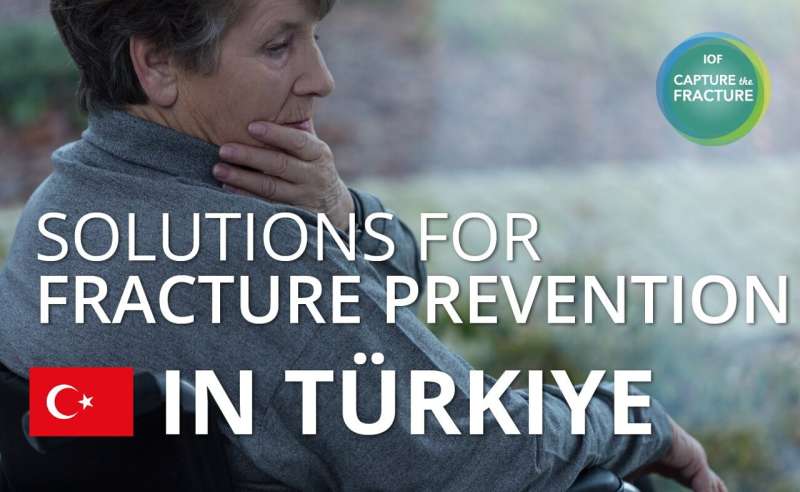This article has been reviewed according to Science X's editorial process and policies. Editors have highlighted the following attributes while ensuring the content's credibility:
fact-checked
trusted source
proofread
New report outlines strategies to tackle the rising number of osteoporotic fractures in Türkiye

An estimated 255,000 fragility fractures occur annually in Türkiye, the equivalent of approximately 29 broken bones per hour. The cause is osteoporosis, a disease in which the skeleton becomes weak and fragile, leading to potentially life-threatening fractures and related disability.
Osteoporosis primarily affects older adults and the proportion of older individuals in Türkiye is increasing rapidly—by 24% over the past five years. Osteoporosis (measured at the hip bone) has been found to be highly prevalent, affecting approximately 33% of Turkish women and 8% of men aged over 50. In fact, compared internationally, Türkiye is a high-risk country for hip fractures, with the lifetime risk of suffering a hip fracture after the age of 50 at 15% in women and 4% in men.
A new report by the International Osteoporosis Foundation (IOF) Capture the Fracture program in collaboration with leading Turkish osteoporosis experts is calling for action to stem the rising tide of fragility fractures. The report 'Solutions for fracture prevention in Türkiye' details the current osteoporosis burden and health care policy landscape in Türkiye, and lists the key policy changes needed to tackle the growing numbers of fragility fractures in the country.
Fragility fractures are a major concern for public health
Professor Dr. Şansın Tüzün of İstanbul University, Cerrahpaşa, chair of the National Council for Secondary Fracture Prevention in Türkiye, and lead author of the report, stated, "We know that a fragility fracture has an immense impact on a patient's quality of life and independence and that approximately 20% of hip fracture patients die within a year of the fracture. Looking at the issue from a broader socio-economic perspective, fragility fractures represent an escalating financial burden which totaled 455 million USD in 2019, including about 347 million USD for hospital costs alone."
"Furthermore, productivity losses affected both patients and their family caregivers, amounting to costs of approximately 103 million USD. It is essential that strategies are put in place to tackle the human and health-economic burden of osteoporosis, which continues to suffer from under-prioritization in our health care system."
Poor treatment initiation is a serious problem, with 75% to 90% of Turkish patients who are at high risk of fracture not receiving effective preventative care. The report points to several challenges and missed opportunities that contribute to the large treatment gap. These include, among others listed in the report, the low prioritization of osteoporosis and fracture prevention in the health care system, lack of awareness of osteoporosis as a disease that affects men too, no common diagnostic consensus, and a restrictive reimbursement policy.
Post-fracture care services are needed to ensure that patients receive effective treatment
A patient who has already sustained a first fragility fracture is at very high risk of recurring fractures. International experts agree that a multidisciplinary, coordinator-based post-fracture care service, most commonly known as a Fracture Liaison Service (FLS), is the best way to ensure that these high-risk patients are identified and offered the post-fracture care they need to regain healthy mobility and prevent future fractures.
Professor Ülkü Akarırmak, Cerrahpaşa Medical Faculty, Department of Physical Medicine and Rehabilitation, and Founding Member of the Turkish Osteoporosis Society, noted, "Anyone who has already broken a bone due to osteoporosis is vastly more likely to sustain another, often life-changing fracture, with the risk highest within two years. Nevertheless, less than 20% of Turkish patients who have fractured receive the post-fracture care needed for the prevention of further fractures."
"Although some progress has been made in the past year, the Turkish population is currently greatly underserved in this regard. That is why experts within the Türkiye National Council for Secondary Fracture Prevention (NCSFP) are calling on health care authorities to support the initiation of FLS services in hospitals that treat fracture patients."
The new report pinpoints five key recommendations to address the growing burden of osteoporosis and related fractures:
- Recognition of osteoporosis as a chronic and progressive condition. This would include providing improved access to and reimbursement of pharmacological treatments and support for the establishment of osteoporosis prevention programs.
- Establishment of more FLS to increase post-fracture screening, diagnosis, treatment rates, and follow-up, including falls prevention services.
- Prioritization of fragility fractures within health care management (including primary care physician awareness and involvement) as well as increasing public awareness of osteoporosis.
- Improve the education of health care professionals, and management of frailty to prevent falls.
- Work both centrally and regionally; collect data and share best practice at a local level leading to the publication of an optimal patient pathway.
Professor Tüzun said, "Experts within the NCSFP, which includes representatives of the Turkish Osteoporosis Society, the Osteoporosis Patient Society of Türkiye, the Society of Life with Osteoporosis, the Society of Endocrinology and Metabolism of Türkiye, the Turkish Society of Physical Medicine and Rehabilitation, the Turkish Orthopaedics and Traumatology Association, and the Fragility Fracture Network Türkiye, are united in our call to action."
"The recommendations outlined must be urgently implemented or reinforced as a line of defense against the increasing fragility fracture crisis in our country."
Dr. Philippe Halbout, CEO of the International Osteoporosis Foundation, thanked the Turkish experts who worked with the IOF Capture the Fracture Policy Group to publish the report, stating, "This is an important policy resource which provides a 'roadmap' of effective solutions that, in synergy, would lead to fewer fractures and reduced health care costs, better patient outcomes, and, most importantly, a healthy, mobile and independent older population in Türkiye."
More information: Report: www.osteoporosis.foundation/si … _turkey_en_final.pdf


















